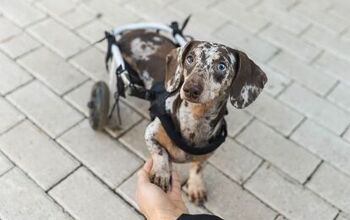What is Brachycephalic Obstructive Airway Syndrome?

What do breeds like the Pug, the Pekingese, the Shih Tzu, and the Boston Terrier all have in common? It may be more than you think! These breeds are not all just similar in size, they are also similar in structure – particularly in the shape of their heads. Short-headed or flat-faced breeds like these are prone to breathing problems caused by certain anatomical abnormalities that result from their shortened facial structure. Keep reading to learn what brachycephalic obstructive airway syndrome is and what you can do about it.
What is Brachycephalic Obstructive Airway Syndrome?
Sometimes shortened to BOAS, brachycephalic obstructive airway syndrome is not a disease – it is a set of anatomical abnormalities which contribute to breathing problems in flat-faced breeds. There are four specific abnormalities that make up this condition:
- Stenotic nares
- Elongated soft palate
- Hypoplastic trachea
- Everted laryngeal saccules
The tern stenotic nares simply refers to narrow nostrils – the narrower the nostrils are, the more difficult it is for a dog to take in enough air. Elongated soft palate refers to an excess of soft tissue in the back of the throat that partially blocks the dog’s larynx, restricting the airway. Hypoplastic trachea describes a trachea (or windpipe) that is smaller in diameter than normal and laryngeal saccules are tiny sacs in the larynx that can be sucked into the airway, causing obstruction.
Do You Need to be Concerned?
If your dog is a flat-faced breed like the Pekingese, Pug, or Boston Terrier, you need to be mindful of potential problems that may develop over your dog’s life. Not all brachycephalic breeds develop breathing problems, but the risks are certainly higher for these dogs. In many cases, symptoms of brachycephalic obstructive airway syndrome are not obvious in puppies but they may become increasingly more apparent as the dog gets older. Keep an eye out for symptoms such as shortness of breath, wheezing, snoring, gagging, and regurgitation.
Though there is no need to be concerned about brachycephalic obstructive airway syndrome until your dog starts showing signs of a problem, you do need to take certain precautions with flat-faced breeds. These dogs have a lower level of exercise tolerance and heat tolerance than other dogs, so be especially careful about limiting the amount of rigorous exercise your dog gets. You should also make sure that if he is going to be outside on a hot day that he has access to shade and fresh water.
If your dog is a brachycephalic breed, you should ask your doctor about signs of brachycephalic obstructive airway syndrome – especially if you notice symptoms such as wheezing or snoring. Your vet will be able to diagnose any anatomical abnormalities that might be affecting your dog’s breathing and he will be able to recommend a course of treatment as well. Brachycephalic obstructive airway syndrome doesn’t have to limit your dog or have a negative effect on his quality of life – you just have to be mindful of the risks and do your job as a dog owner in making sure your dog is properly cared for.

Kate Barrington is the loving owner of two cats (Bagel and Munchkin) and a noisy herd of guinea pigs. Having grown up with golden retrievers, Kate has a great deal of experience with dogs but labels herself a lover of all pets. Having received a Bachelor's degree in English, Kate has combined her love for pets and her passion for writing to create her own freelance writing business, specializing in the pet niche.
More by Kate Barrington






















